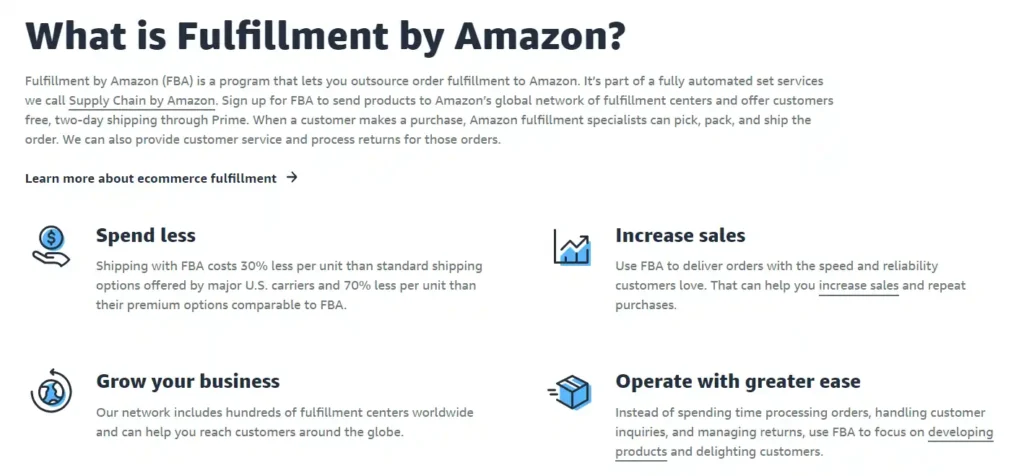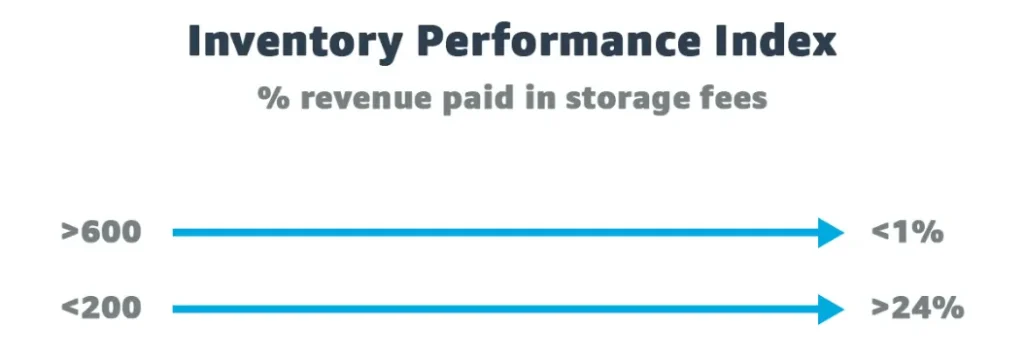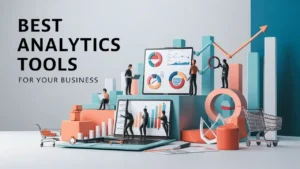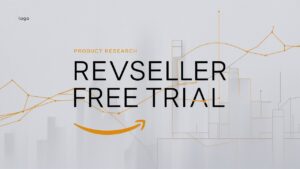
Selling on Amazon's massive marketplace is a goldmine for entrepreneurs, but calculating the fees can feel like a minefield. In 2022, a staggering 37.7% of all U.S. e-commerce sales went through Amazon's platform. With that much revenue up for grabs, it's no wonder over 1.5 million small and medium-sized businesses sell on Amazon.
However, Amazon's Fulfillment by Amazon (FBA) program comes with a dizzying array of fees that can quickly eat into your profits if you're not careful. From referral fees that can reach 45% to fulfillment fees based on size and weight, it's crucial to understand exactly what you'll be charged to sell successfully on Amazon.
Amazon's Fulfillment by Amazon (FBA) program provides immense convenience by handling storage, packing, and shipping for you. However, this white-glove service comes at a cost in the form of various FBA fees you must pay Amazon.
Don't let confusing fee structures nickel and dime you out of your hard-earned sales. With some know-how, you can master Amazon's fee landscape and maximize your profits on the world's top e-commerce site.
Why To Calculate Amazon FBA Fees?
Selling on Amazon's massive marketplace is a lucrative opportunity, but a dizzying array of fees can quickly eat into your profits if you're not careful. Understanding Amazon's fee structure is crucial for maximizing your margins and maintaining profitability.

Precisely forecasting your FBA costs allows you to:
- Set competitive prices that account for Amazon's cut
- Manage cash flow by understanding your true profit margins
- Drive sustainable growth on the world's top e-commerce platform
Failing to calculate your FBA fees accurately is a surefire way to watch your margins shrink. One study found that 36% of Amazon sellers consider FBA fees to be their biggest challenge.
Miscalculating fees can lead to disastrous consequences like cash flow crunches and eroding margins that threaten your business's viability.
A Headshot At Amazon Fee Types!
Amazon charges a variety of fees that all sellers must account for:
- Selling Plan Fees: Subscription fees based on your chosen selling plan tier
- Referral Fees: A percentage cut of each sale (8-15% typically)
- FBA Fulfillment Fees: Fees for Amazon to store, pick, pack and ship your products
- FBA Storage Fees: Monthly fees for the space your inventory occupies in Amazon's warehouses
- Other Fees: Returns, removals, unplanned services, and more
Amazon Selling Plan Fees
To even list products on Amazon, you must first pay a selling plan subscription fee. There are two options:
| Feature | Individual Plan | Professional Plan |
|---|---|---|
| Monthly Subscription Fee | None | $39.99 |
| Per Item Sold Fee | $0.99 | None |
| Eligibility Threshold | Best if selling < 40 items/month | Best if selling > 40 items/month |
Most high-volume FBA sellers opt for the Professional plan to avoid per-item fees eating into margins.
Referral Fees By Amazon
In addition to selling plan fees, Amazon takes a percentage cut of each sale in the form of a referral fee. These fees help fund Amazon's operating costs and are unavoidable when selling on their platform.
How Referral Fees Are Determined?
Referral fees are calculated as a percentage of the total sales price, including item price and any shipping or gift-wrap charges. However, they do not apply to any expected FBA fees or other selling costs.
| Product Category | Referral Fee |
|---|---|
| Most Categories | 8% |
| Clothing/Accessories | 15% |
| Amazon Device Accessories | Up to 45% |
Strategies To Minimize Referral Costs
While referral fees are unavoidable, there are ways to reduce the impact:
- Optimize pricing: Factor referral fees into your pricing strategy from the start
- Sell higher-priced items: Referral fees are lower percentages on pricier goods
- Focus on low referral categories: Stick to categories with 8-12% fees if possible
- Use FBA for high referral categories: FBA may offset high referral costs
Fulfillment By Amazon Fees (FBA)

If you use Amazon's FBA service, you'll pay fulfillment fees based on the product's dimensions and shipping weight. These fees increase exponentially for larger and heavier items.
These are the fees Amazon charges for picking, packing, and shipping your products directly to customers.
Fulfillment fees vary based on three key factors:
- Product Dimensions and Weight
The larger and heavier your product, the higher the fulfillment fee. Amazon uses a complex matrix of size tiers and weights. - Product Category
There are different fee schedules for product categories like apparel vs non-apparel items. - Size Tier
Products are classified into tiers like small standard, large standard, oversize, etc. Higher tiers mean higher fees.
Here are the fulfillment fee ranges for standard size non-apparel items:
| Product Size | Fee Range |
|---|---|
| Small Standard | $2.70 – $4.90 |
| Large Standard | $3.93 – $8.51 |
| Small Oversize | $9.73 – $27.36 |
| Large Oversize | $79.84 – $179.28 |
The key is to keep your products and packaging as compact as possible to minimize fulfillment costs. Amazon uses dimensional weight pricing, so bulky items get pricey fast.
Monthly Storage Fees
You'll also pay monthly fees for the space your inventory occupies in Amazon's fulfillment centers. These storage fees depend on:
- Daily Average Volume (cubic feet) of inventory
- Product Size Tier (standard vs oversize)
- Product Category (e.g. apparel vs non-apparel)
- Time of Year
For example, here are the January 2023 storage fees:
| Product Type | Fee per Cubic Foot |
|---|---|
| Standard Non-Clothing | $0.83 |
| Oversize Non-Clothing | $0.53 |
| Clothing | $0.89 |
However, fees spike during peak Q4 season when warehouses are at capacity.
Other Potential Amazon FBA Fees
But wait, there's more! On top of selling plan fees, referrals, fulfillment, and storage, Amazon has introduced several new fees in recent years:
1. Aged Inventory Surcharge: $1.50 per cubic foot for products stored over 365 days
2. Storage Utilization Surcharge: Extra fees for inefficient use of warehouse space
3. Removal and Disposal Fees: Charged when you need to remove or dispose of inventory
| Weight Range | Fee Per Shipment |
|---|---|
| <= 1 lb | $0.97 |
| 1 – 2 lbs | $1.19 |
| > 70 lbs | $13.05 |
4. Returns processing fees: Charges for handling customer returns.
5. Unplanned service fees: Penalties for improperly prepared inventory.
With so many different fee types based on complex variables like product dimensions, sales volumes, and storage duration, it's crucial to leverage fee calculators and optimization strategies to accurately forecast your total costs.
Using Amazon's Built-In Fee Calculators

One of the most useful calculators is the FBA Revenue Calculator. This tool allows you to input details about a product like:
- Selling price
- Product dimensions and weight
- Product category
The calculator will then provide an estimate of the fees you can expect, including:
- Referral fees
- Fulfillment fees
- The total fees as a percentage of the selling price
Example Of Amazon FBA Fee Calculation
To illustrate how quickly fees can add up, let's look at an example product:
| Product Details | |
|---|---|
| Product Price | $19.99 |
| Product Weight | 8 oz |
| Dimensions | 8″ x 6″ x 3″ |
Using Amazon's free FBA revenue calculator, the estimated fees break down as:
- Referral Fee: $2.40 (12%)
- Fulfillment Fee: $3.51
- Total Fees: $5.91
So on a $19.99 item, your Amazon fees are nearly 30% of the selling price – a significant chunk! And we haven't even included potential storage fees or other surcharges.
Amazon ‘Fee Preview Report' Functionality
Amazon's Fee Preview report is an invaluable tool for sellers to accurately estimate their total fees and profitability based on real sales data. Rather than relying on hypothetical scenarios, the Fee Preview leverages your actual orders and inventory to forecast fees with pinpoint accuracy.
The report is accessible right within your Seller Central account under the “Reports” section. Simply select the “Fee Preview” type, choose your date range, and Amazon will generate a detailed breakdown of:
- Referral Fees based on your product categories and sales prices
- Fulfillment Fees calculated from your actual product dimensions and weights
- Storage Fees determined by your average inventory volume over time
- Other Fees like returns processing charges
The data is compiled into an easy-to-read table, allowing you to analyze fees at the order level, product level, or get a total rollup. For example:
| Fee Type | Total Fees |
|---|---|
| Referral | $527.39 |
| Fulfillment | $1,284.62 |
| Storage | $193.75 |
| Other | $67.20 |
| Total Fees | $2,072.96 |
With this level of detail, you can identify your biggest fee drivers and opportunities for optimization.
The Fee Preview also accounts for things like:
- Promotions and Pricing Adjustments: See fee impacts of your discounts and coupons
- Multi-Channel Orders: Fees for orders from other sales channels like your website
- Fee Estimates vs Actual: Compare estimated fees to what you were actually charged
Armed with this level of transparency, you can make data-driven decisions to control costs, set accurate pricing, and maintain healthy profit margins when selling on Amazon's marketplace.
While Amazon's built-in Fee Preview is powerful, many sellers also leverage third-party fee analytics tools for even more robust reporting and forecasting capabilities.
But for a clear, real-time view into your Amazon fees, the Fee Preview report is an essential first step.
Strategies To Reduce FBA Costs

With Amazon's fees rising rapidly, it's more important than ever to optimize your processes. Here are some tips:
1. Optimize Product Dimensions and Weight
- Minimize packaging size to reduce dimensional weight and fulfillment fees
- Use lightweight materials like air pillows instead of bulky fillers
- Measure products accurately to avoid oversize or overweight fees
2. Manage Inventory Efficiently
- Forecast demand accurately to avoid overstocking
- Implement just-in-time inventory practices
- Rotate slow-moving inventory through promotions or bundles
- Maintain a high Inventory Performance Index (IPI) score
3. Choose the Right Product Categories
- Sell in categories with lower referral fee rates
- Focus on high-demand, fast-moving products
- Participate in programs like FBA New Selection for reduced fees
4. Streamline Shipping and Fulfillment
- Consolidate shipments to Amazon fulfillment centers
- Maximize shipment density by efficient packing
- Use Amazon-partnered carriers for negotiated rates
5. Leverage Amazon's Discounts and Incentives
- Enroll in the Brand Referral Bonus program
- Utilize the Small and Light program for eligible products
- Take advantage of multi-channel fulfillment options
Explore These Top Amazon FBA Fee Calculators!
While Amazon's built-in tools are useful, many sellers prefer third-party FBA fee calculators for more robust functionality and insights.

AMZScout offers a free Chrome extension called the “FBA Calculator” that shows Amazon fees, sales margins, revenue, and estimated net profit for any product listing on Amazon. It calculates referral fees, fulfillment fees, storage fees, and provides data like profit per unit, net margin, ROI, etc.
Jungle Scout has an “FBA Profit Calculator” built into their Chrome extension and web app. It allows you to calculate potential profits and ROI by inputting your product costs and having Jungle Scout estimate Amazon fees based on the product details.


Helium 10‘s Profitability Calculator is a powerful free tool that allows you to accurately estimate your Amazon FBA fees and overall profitability. You can connect your actual Amazon seller account for live data integration or input hypothetical product details for “what-if” analysis.
Spocket has an FBA fee calculator integrated into their dropshipping platform to help estimate Amazon fees when selling products sourced through Spocket.

Math Your Amazon FBA Fees!
Thinking about selling on Amazon but confused by all the fees?
You're not alone – Amazon's fee structure is a total labyrinth that can quickly turn your profits into losses if you're not careful. We're talking referral fees, fulfillment fees, storage fees, and more – it's enough to make your head spin!
Look, selling on Amazon's massive marketplace is an incredible opportunity. But failing to understand their confusing fee structure is a surefire way to watch your hard-earned profits get flushed down the toilet.
Imagine knowing exactly how much Amazon is going to charge you for each product before you even send in inventory?
That's where fee calculators come in. These handy little tools let you plug in your product details like size, weight, and category to see the full fee breakdown. Bam – no more surprises when you get that first disbursement from Amazon.
The key is using the right tools to forecast your fees accurately based on your actual products and sales data. Because guessing games have no place in a real business! With some know-how, you can crack Amazon's fee code and start profiting instead of paying through the nose.







